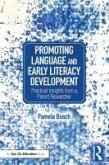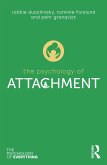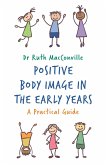Karen Morris
Promoting Positive Behaviour in the Early Years
Karen Morris
Promoting Positive Behaviour in the Early Years
- Broschiertes Buch
- Merkliste
- Auf die Merkliste
- Bewerten Bewerten
- Teilen
- Produkt teilen
- Produkterinnerung
- Produkterinnerung
This book considers theory and recent research on children's social and emotional development, highlighting the implications for effective practice in promoting positive behaviour.
Andere Kunden interessierten sich auch für
![Promoting Emotional Wellbeing in Early Years Staff Promoting Emotional Wellbeing in Early Years Staff]() Sonia Mainstone-CottonPromoting Emotional Wellbeing in Early Years Staff28,99 €
Sonia Mainstone-CottonPromoting Emotional Wellbeing in Early Years Staff28,99 €![Promoting Language and Early Literacy Development Promoting Language and Early Literacy Development]() Pamela BeachPromoting Language and Early Literacy Development31,99 €
Pamela BeachPromoting Language and Early Literacy Development31,99 €![Promoting British Values in the Early Years Promoting British Values in the Early Years]() Julia Gouldsboro (UK Early Years Consultant)Promoting British Values in the Early Years34,99 €
Julia Gouldsboro (UK Early Years Consultant)Promoting British Values in the Early Years34,99 €![Quality in the Early Years Quality in the Early Years]() Emma SlaughterQuality in the Early Years34,99 €
Emma SlaughterQuality in the Early Years34,99 €![The Psychology of Attachment The Psychology of Attachment]() Robbie DuschinskyThe Psychology of Attachment15,99 €
Robbie DuschinskyThe Psychology of Attachment15,99 €![Positive Body Image in the Early Years Positive Body Image in the Early Years]() Ruth MacConvillePositive Body Image in the Early Years26,99 €
Ruth MacConvillePositive Body Image in the Early Years26,99 €![Observation, Assessment and Planning in the Early Years Observation, Assessment and Planning in the Early Years]() Kathy BrodieObservation, Assessment and Planning in the Early Years45,99 €
Kathy BrodieObservation, Assessment and Planning in the Early Years45,99 €-
-
-
This book considers theory and recent research on children's social and emotional development, highlighting the implications for effective practice in promoting positive behaviour.
Produktdetails
- Produktdetails
- Verlag: Open University Press
- ed
- Seitenzahl: 186
- Erscheinungstermin: 1. Juni 2015
- Englisch
- Abmessung: 229mm x 152mm x 10mm
- Gewicht: 284g
- ISBN-13: 9780335262984
- ISBN-10: 0335262988
- Artikelnr.: 41628809
- Herstellerkennzeichnung
- Libri GmbH
- Europaallee 1
- 36244 Bad Hersfeld
- gpsr@libri.de
- Verlag: Open University Press
- ed
- Seitenzahl: 186
- Erscheinungstermin: 1. Juni 2015
- Englisch
- Abmessung: 229mm x 152mm x 10mm
- Gewicht: 284g
- ISBN-13: 9780335262984
- ISBN-10: 0335262988
- Artikelnr.: 41628809
- Herstellerkennzeichnung
- Libri GmbH
- Europaallee 1
- 36244 Bad Hersfeld
- gpsr@libri.de
Karen Morris is Senior Lecturer and Programme Leader for the foundation degree and undergraduate degree in Childhood Studies at the University of Winchester, UK.
1.Introduction
PART 1 - Relatedness: 'I Belong'
Introduction to Part 1
2.The Value of a Secure Attachment Bond: 'I need to feel safe, special and
valued.'
3.Insecure Attachments and Ways to Help: 'Understand that this behaviour
started as self-protection'
PART 2 - Autonomy: 'Being Me'
Introduction to Part 2
4.Boundary Setting: 'I need to explore and find out about the world and
myself within managed boundaries'.
5.Emotions: 'I need to understand my own feelings and how to use them
constructively'
6.Unique but Belonging: 'I want to be me but I still need to be loved'
PART 3 -Competence: 'I Can'
Introduction to Part 3
7. How Competence Develops: 'I need to feel I can make a difference'
8.Communication Skills and Behaviour: 'I need to understand and make myself
understood'
9.Competence and Executive Functions: 'I need the right sort of
opportunities and support to practise skills such as paying attention,
waiting and managing impulses'
PART 4 - Collaborating for Positive Behaviour: 'Together we can'
Introduction to Part 4
10.Planning for Positive Behaviour: practitioner viewpoints
11.Planning for Positive Behaviour: parent viewpoints
Glossary
References
PART 1 - Relatedness: 'I Belong'
Introduction to Part 1
2.The Value of a Secure Attachment Bond: 'I need to feel safe, special and
valued.'
3.Insecure Attachments and Ways to Help: 'Understand that this behaviour
started as self-protection'
PART 2 - Autonomy: 'Being Me'
Introduction to Part 2
4.Boundary Setting: 'I need to explore and find out about the world and
myself within managed boundaries'.
5.Emotions: 'I need to understand my own feelings and how to use them
constructively'
6.Unique but Belonging: 'I want to be me but I still need to be loved'
PART 3 -Competence: 'I Can'
Introduction to Part 3
7. How Competence Develops: 'I need to feel I can make a difference'
8.Communication Skills and Behaviour: 'I need to understand and make myself
understood'
9.Competence and Executive Functions: 'I need the right sort of
opportunities and support to practise skills such as paying attention,
waiting and managing impulses'
PART 4 - Collaborating for Positive Behaviour: 'Together we can'
Introduction to Part 4
10.Planning for Positive Behaviour: practitioner viewpoints
11.Planning for Positive Behaviour: parent viewpoints
Glossary
References
1.Introduction
PART 1 - Relatedness: 'I Belong'
Introduction to Part 1
2.The Value of a Secure Attachment Bond: 'I need to feel safe, special and
valued.'
3.Insecure Attachments and Ways to Help: 'Understand that this behaviour
started as self-protection'
PART 2 - Autonomy: 'Being Me'
Introduction to Part 2
4.Boundary Setting: 'I need to explore and find out about the world and
myself within managed boundaries'.
5.Emotions: 'I need to understand my own feelings and how to use them
constructively'
6.Unique but Belonging: 'I want to be me but I still need to be loved'
PART 3 -Competence: 'I Can'
Introduction to Part 3
7. How Competence Develops: 'I need to feel I can make a difference'
8.Communication Skills and Behaviour: 'I need to understand and make myself
understood'
9.Competence and Executive Functions: 'I need the right sort of
opportunities and support to practise skills such as paying attention,
waiting and managing impulses'
PART 4 - Collaborating for Positive Behaviour: 'Together we can'
Introduction to Part 4
10.Planning for Positive Behaviour: practitioner viewpoints
11.Planning for Positive Behaviour: parent viewpoints
Glossary
References
PART 1 - Relatedness: 'I Belong'
Introduction to Part 1
2.The Value of a Secure Attachment Bond: 'I need to feel safe, special and
valued.'
3.Insecure Attachments and Ways to Help: 'Understand that this behaviour
started as self-protection'
PART 2 - Autonomy: 'Being Me'
Introduction to Part 2
4.Boundary Setting: 'I need to explore and find out about the world and
myself within managed boundaries'.
5.Emotions: 'I need to understand my own feelings and how to use them
constructively'
6.Unique but Belonging: 'I want to be me but I still need to be loved'
PART 3 -Competence: 'I Can'
Introduction to Part 3
7. How Competence Develops: 'I need to feel I can make a difference'
8.Communication Skills and Behaviour: 'I need to understand and make myself
understood'
9.Competence and Executive Functions: 'I need the right sort of
opportunities and support to practise skills such as paying attention,
waiting and managing impulses'
PART 4 - Collaborating for Positive Behaviour: 'Together we can'
Introduction to Part 4
10.Planning for Positive Behaviour: practitioner viewpoints
11.Planning for Positive Behaviour: parent viewpoints
Glossary
References








